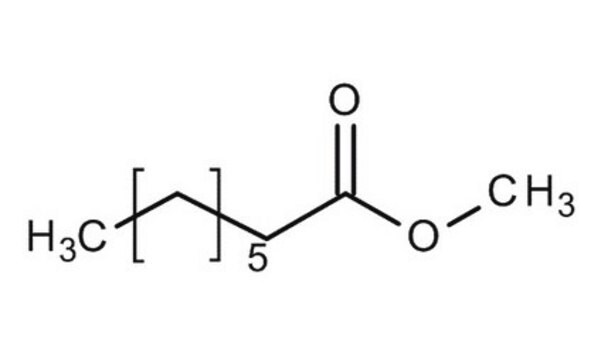299030
Methyl decanoate
99%
Sinonimo/i:
Capric acid methyl ester, Decanoic acid methyl ester, Methyl caprate
About This Item
Prodotti consigliati
Saggio
99%
Forma fisica
liquid
Indice di rifrazione
n20/D 1.425 (lit.)
P. eboll.
108 °C/10 mmHg
224 °C (lit.)
Punto di fusione
−14-−11 °C (lit.)
Solubilità
chloroform: soluble 100 mg/mL, clear
Densità
0.871 g/mL at 20 °C (lit.)
Stringa SMILE
CCCCCCCCCC(=O)OC
InChI
1S/C11H22O2/c1-3-4-5-6-7-8-9-10-11(12)13-2/h3-10H2,1-2H3
YRHYCMZPEVDGFQ-UHFFFAOYSA-N
Cerchi prodotti simili? Visita Guida al confronto tra prodotti
Descrizione generale
Applicazioni
- Application of mist to fingermark detection: Misting with high-boiling-point liquid containing p-dimethylaminocinnamaldehyde and cyanoacrylate.: This article explored the use of high-boiling-point liquids, including methyl decanoate, in misting techniques for forensic fingermark detection. (Takatsu et al., 2023).
Avvertenze
Warning
Indicazioni di pericolo
Consigli di prudenza
Classi di pericolo
Aquatic Acute 1 - Aquatic Chronic 2
Codice della classe di stoccaggio
10 - Combustible liquids
Classe di pericolosità dell'acqua (WGK)
WGK 1
Punto d’infiammabilità (°F)
230.9 °F - Pensky-Martens closed cup
Punto d’infiammabilità (°C)
110.5 °C - Pensky-Martens closed cup
Dispositivi di protezione individuale
Eyeshields, Gloves, type ABEK (EN14387) respirator filter
Certificati d'analisi (COA)
Cerca il Certificati d'analisi (COA) digitando il numero di lotto/batch corrispondente. I numeri di lotto o di batch sono stampati sull'etichetta dei prodotti dopo la parola ‘Lotto’ o ‘Batch’.
Possiedi già questo prodotto?
I documenti relativi ai prodotti acquistati recentemente sono disponibili nell’Archivio dei documenti.
I clienti hanno visto anche
Il team dei nostri ricercatori vanta grande esperienza in tutte le aree della ricerca quali Life Science, scienza dei materiali, sintesi chimica, cromatografia, discipline analitiche, ecc..
Contatta l'Assistenza Tecnica.










